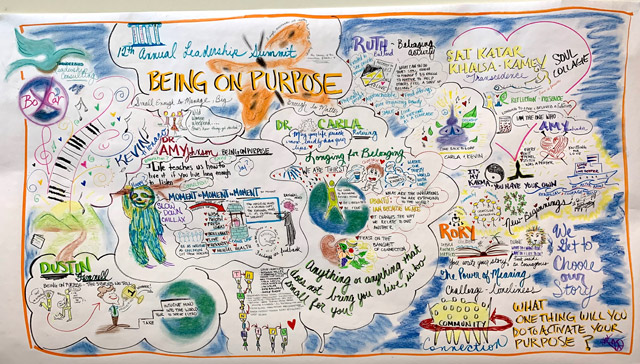From our inbox:
Dear Thunderbird Leadership Consulting,
My boss can be a difficult woman. She tells me one thing in a face to face meeting then changes her mind. I had geared myself up to support a new policy about time off and when she announced exactly the opposite in public I didn’t know how to react. I’m afraid I said something to my staff that made them think I couldn’t support her. What should I do?
~Donna
Help! I can’t seem to satisfy my supervisor, no matter how hard I try. He has talked about the importance of having a comfortable workplace, but when I make a joke in a meeting, he shoots me a glance that says I shouldn’t have, and it was a clean joke! He asked for a report that took me a long time to pull together, and when it wasn’t on his desk in 2 days, he was all over my case about it. Then when he found me taking a break with the guys I used to work with, (I’m their boss now), he raised his eyebrows as if to say I shouldn’t be friendly with them anymore. We seem to be in agreement about what I need to be doing, and I am definitely on board with his goals. But things seem kind of tense a lot of the time. Any ideas?
~Andy
I come to work every day dreading it. I am terrified of my boss. I have tried being nice, asking him how I can do my job better, taking classes, asking my co-workers for advice. We are all afraid. I have had this job for almost a year, and I dread my annual review. . . if I ever get one! I really need this job as my position is very specialized, and I would have to make a significant move to get a comparable one.
~Jackie
Hello, I just learned about managing up in a leadership class, and someone suggested that you can use managing up when things are going well, instead of thinking just about fit and style. Here are 2 positive situations. One of my employees came up with a brilliant idea for tracking a problem that has plagued our department for the past 2 years. My boss received an award for outstanding financial performance at the regional level. I have said thank you, and congratulations to the individuals, but as a good manager, should I be doing something more?
~Jennifer
These issues all have a common theme, that of managing up, a concept that shows up in business advice a lot these days. It has a number of definitions, and one that I particularly like is Mary Abbajay’s . . . “Managing up is about consciously and deliberately developing and maintaining effective relationships with supervisors, bosses and other people above you in the chain of command.”[1] Managing up is a set of familiar skills that most of us will need at one time or other in our careers, because most of us have someone we report to. . . even CEOs have Boards of Directors or shareholders to consider. The managing up skills require us to be great followers, and in so doing, we also develop our leader muscles. But there can be a downside when managing up is misunderstood or misapplied. “When the practice of managing up gets confused with promotion of self-interest, brown-nosing, manipulation, the gymnastics of corporate climbing, or other mind games, a good theory rapidly becomes twisted resulting in a false and dangerous reality.”[2] The bottom line is that managing up involves straightforward approaches, based on assessment and intention, rather than subtle manipulation. Managing up helps you be more effective in your work. The question is, if your boss asked you what you are doing differently in your approach with her, could you comfortably tell her how you are managing up? If the answer is yes, you are good.
So how does someone manage up appropriately? Some would argue that managing up is nothing different from ‘doing your job’. I call that the ‘what’ of your work . . . what your job description says. But to be most effective, most satisfying and most likely to result in you staying in the job as long as you want, you need to consider the ‘how’ of your work. . . especially how you interact with people; peers, your staff, customers, and your boss. Rare in the workplace is the perfectly synchronized boss and subordinate relationship. Most of the time there are glitches and rubs, and sometimes there are extremely difficult bosses and situations. Most of us have relationships in the vast middle.
In order to manage up better, you need a roadmap. According to Abbajay, you only have 3 choices when managing up; 1) change your boss (never gonna happen, she says), 2) leave your job (may be necessary in extreme cases), and 3) you guessed it, change YOUR approach. Changing your approach may feel unfair at times, or frustrating, but it’s the only way to make a difference, AND you will likely learn a lot in the process. So, take it as a personal growth and leadership challenge.
The first thing to consider is style. What is your boss’s style, strengths and weakness, and what are yours? How do these styles fit together, and what are the natural, BUILT-IN, conflict spots? What are your boss’s hot buttons? In her book, Abbajay identifies 4 workplace personalities (Energizer, Advancer, Harmonizer and Evaluator), and ten difficult boss styles, (Micromanager, Narcissist, Impulsive, etc) with proven strategies to manage up to them. There are a number of good behavioral style assessments (DiSC, Myers-Briggs, etc) available, and your organization may use one of them. If so, take advantage of the information it provides to guide your interactions for the best possible outcome.
Rather than go into detail on a specific assessment method here, consider for example, whether you and your boss are introverts, extroverts, or both. We know that, in general, introverts move at a slower pace, prefer a quieter environment and need alone process time. At the opposite end, extroverts move quickly, prefer a busy and energetic environment, and often process in a talking out loud manner with others. If you work with an extroverted boss, you need to account for pace. . . when does she need the report? Can you lump your project related questions into one meeting? Does your boss know your timeline for getting the report into him on time? If your supervisor is an introvert, give him a draft report first with time to think and respond. Don’t expect to drop in and socialize. And if you and your boss are the same on the introvert-extrovert (I-E) scale, beware of the false sense of security that a possibly easier relationship brings. I-I may not move quickly enough for a project, and E-E may have task completion problems.
Here are a few more general principles to help you manage up successfully.
Communicate. Communicate some more. Tell your boss where you are on the project before she asks about it.Take the initiative to find out when and how your supervisor wants reports, feedback, information, updates. . . is time of day important to them? What about method? A paper trail of emails, texts? Phone call, face to face? Don’t assume that just because she hasn’t asked you for something, that it is not due. It’s always better to be early than late with a report.
Honor your boss’s time. This goes for all boss types. And if you are a chatty, conversational type, take steps to reduce your wordiness. Figure out the main point first. . . Use bullet points, and separate actionable items from background information in written formats.
Provide solutions, not problems. This is not to say that you should never bring a problem, but focusing on what you think it will take to fix the problem brings a lot of value to your boss. Rather than making your problem his, you become partners in a solution. This approach directs the conversation to a higher level, for example, anticipating together what will happen if option A is followed instead of option B.
Never let your boss get blindsided. If you are aware of factors that could affect your timing on a project budget, for example, let your boss know that as soon as you can, NOT when the budget is due.
And finally, NEVER go over the boss’s head or behind his back unless your project is on the line, and there is an urgent problem that continues to be ignored, or the boss is doing something illegal, has a serious illness, (including mental illness, substance abuse) or is doing something that could result in a lawsuit. [3] Hopefully none of our readers has a situation like this.
And now, back to our inbox.
Donna, how you support your boss in front of others is a crucial part of managing up. If you disagree with your boss, never say it in public. Bring it to the boss first, respectfully, and let them know of your objections. Then if the disagreement is not at the level of making you quit, keep your thoughts to yourself. Or share with an objective outsider, such as a coach. You could consider saying something to your staff about your surprise at the policy, and your willingness to follow it. Something like this: “I was thinking about the policy discussion at the meeting yesterday, and I may have given you a wrong impression. I know I was surprised, but I am on board with it, and am supportive of the boss.” Then no more discussion. . . the less said the better.
Andy, there’s a lot to comment on in your note. The first thing is to evaluate how well you are matching your work style to your boss’s style. Is it possible he takes a more formal approach, and you a more casual one? Do you know how he wants information from you? Have you made a meeting to discuss how the two of you can work together in the smoothest way? Does he know that you are totally on board with his goals? Finally, consider asking him what he thought about you taking a break with your staff. . . don’t ever assume, but take steps to understand his perspective and clarify where he is coming from.
Jennifer, you made a great point. Managing up is not just for difficult situations, but for celebrations as well. As a middle manager, one of your roles is to promote the actions of one level to the other, because you are all working together to advance your organization and its mission. Do your staff know about your boss’s award? Is there an opportunity to have both your staff and your boss together to talk about the award? And, how about recognizing your employee in front of your boss about the fine work he did with the tracking system?
Jackie, what are your specific issues with your boss? How does he terrify you? Do you know what is motivating this behavior, why he is acting the way he is? What managing up principles have you tried, in particular, flexing your style to accommodate his? Working with more difficult bosses is certainly a challenge, but your situation suggests that some more time, and more intentional actions on your part could be worth it.
Managing up has limits, however, especially when your sense of integrity and values are threatened. Sometimes leaving a situation is the best solution. Working with a boss who creates a toxic workplace is full of problems. No one wants to walk on eggshells and wonder how they will be received. It is very stressful, not to mention unproductive, to be in a position where you can’t predict from one day to the next if your boss is going to be agitated, friendly, upset, or moody. You may find that a move is a great new start for you, or work at a different level or role has more benefits than you first thought. The bottom line question is this: what can you live with, and feel good about? Only you can answer this question for yourself. Carrying the burden of stress has a big and negative impact on our health, and, life is short. Good luck!
______________________________
[1] Abbajay, M. 2018. Managing Up: how to move up, win at work, and succeed with any type of boss.1.Wiley.
[2] Wyatt, M. 2012. “My Advice on Managing Up: Don’t.” forbes.com Accessed online, 2/6/2019.
[3] Turk, W. 2007. The Art of Managing Up. Defense AT&L. Accessed online 2/5/2019. www.uthscsa.edu.










